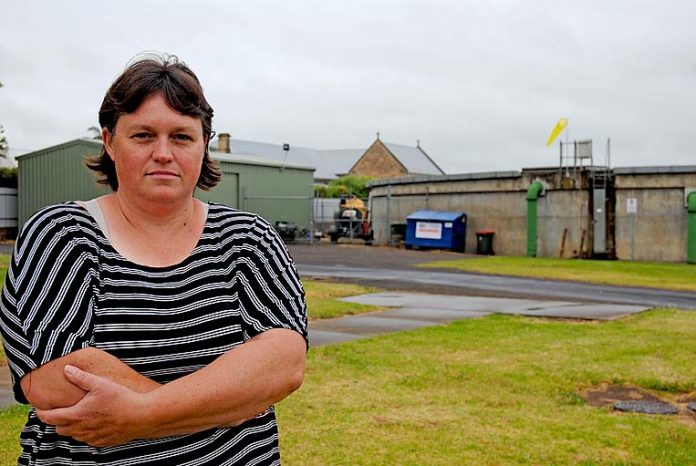

A MILLICENT resident is opposing a licence application by SA Water to temporarily store small quantities of non-friable asbestos at its depot near her home, other houses, Millicent Hospital and St Anthony’s School.
The Environment Protection Authority has invited public comment on the application until December 1 and Tina Steinborner is voicing her strong opposition.
SA Water has stated that no such material is currently stored at Millicent and it is unlikely to do so in the future, but Ms Steinborner is not satisfied.
“I think it is the wrong thing to do,” Ms Steinborner said.
“It is not an appropriate location to store asbestos.
“The EPA has told me on the phone the asbestos material will be stored at Millicent until there is still a sufficient load.
“What does it mean when it says the storage will be temporary?
“We were told by the State Government in 2013 that it was temporary that obstetrics would be withdrawn from Millicent Hospital and were told last year that locum doctors would be a temporary measure at the Millicent Hospital.”
Ms Steinborner said obstetrics was no longer available at the hospital and locum doctors were still staffing the facility.
“They could continue to store asbestos material at Millicent for years,” she said.
“In the case of a fire, I believe it would be necessary to evacuate the school and the hospital due to the potential risk of asbestos.
“I am worried about property values, but my main fear is the health risk to the community.”
SA Water customer field services senior manager Colin Bell said similar applications for EPA storage licences had been made at 30 other sites across the state.
Mr Bell said the application refers to asbestos cement pipes that have been removed from the SA Water network when undertaking repairs.
He said the material is double-wrapped in protective plastic and temporarily held in designated storage bins on secure sites away from public access.
“Temporarily holding the pipes at our sites means they are kept safe until they can be permanently disposed of at a licensed facility,” Mr Bell said
“Typically, any of this material generated around Millicent is taken straight to Mount Gambier, but there may be occasions where this is not immediately possible and needs to be safely and securely stored for a short period of time.
“SA Water does not – and is not proposing to – undertake any asbestos processing or any change to our existing safe practices, which are in accordance with the Australian Code of Practice for Managing Asbestos Containing Materials and relevant work health and safety regulations.
“Recent licence notifications made by the EPA are simply to formalise our long-held safe practices.
“The EPA has confirmed these existing practices do not represent a risk to workers, the public or the environment.”
Mr Bell said SA Water has a licence to remove Class B asbestos (non-friable) and staff who work with this material are specially-trained to ensure their safety and that of the wider community.
“This is in accordance with the Australian Code of Practice for Managing Asbestos Containing Materials and relevant Work Health Safety (WHS) regulations,” he said.
“The presence of asbestos cement pipes within our water network does not pose a drinking water health risk to the public.
“This is in keeping with the findings of the World Health Organisation and National Health and Medical Research Council’s Australian Drinking Water Guidelines.”
An SA Water spokesman said it was the intention to promptly transfer affected material from Millicent to Mount Gambier.
The South Eastern Times has sought a response from Millicent and District Hospital via the Adelaide-based Country Health SA media unit.
This newspaper has also sought a response from the EPA and St Anthony’s School.
The area in question was the subject of a high-profile dispute in the mid-1990s when mobile phone aerials were installed on the tall concrete water tower.
St Anthony’s School cited health concerns in its protest, but the installations went ahead.







